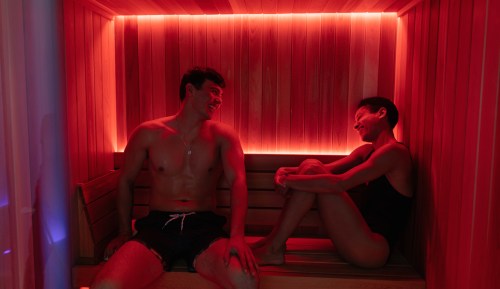Kiss stretching and foam rolling buh-bye! Recovery can feel like a day at the spa
These relaxing workout recovery techniques will help heal your body after an intense exercise regime and zen you out in the process.

I’ve got a confession to make: Despite knowing exactly how important recovery is (I spend like, 80 percent of my time writing about it), I rarely actually do it. I prioritize squeezing workouts into my schedule, but don’t give recovery sessions the same VIP treatment. Stretching sessions feel like a major snooze, and I’d honestly rather take another semester of AP calculus than foam roll (I know! I know!). Recovery activities tend to feel like as much output energy as the workout itself, so I usually opt to skip them instead of making time.
So when I got an email earlier this week from the team behind Core Power High Protein Recovery Shakes revealing the recovery routines of some top trainers and athletes, I was shocked to find that a lot of them sounded a whole lot more like spa treatments than what I usually associate with recovery. “This,” I thought, “I can get on board with.”
While stretching and foam rolling are definitely important elements of any routine (do as I say, not as I do), there are other things you can do for your muscles that you’ll actually look forward to…which means you’ll be more likely to make time for them in your schedule.
Acupuncture
People swear by acupuncture for everything from jaw tension to glowing skin, and it can also be a powerful tool for recovery. “I strongly recommend using acupuncture as part of a lifestyle and wellness routine to prevent and minimize pain, inflammation, and injury,” says Juhi Singh, MA, LAc. “By creating a micro-trauma, acupuncture allows your body to recover quicker by healing all of the inflamed surrounding tissues. The prick of the needle increases blood flow to the affected muscles and decreases recovery time in between workouts.”
Hydrotherapy
There’s a reason why dipping into a tub after an intense workout feels so damn good. “Hydrotherapy can be very helpful in muscle body recovery because the use of hot and cold water elements of soaking, steam, and sauna help to detoxify the body and rid the body of lactic acid that builds up in the muscles after workouts often causing muscle pain and soreness,” explains Elizabeth Tortolani, founder of CityWell, a “boutique bathhouse” in Brooklyn. “Going from hot to cold to hot again stimulates the lymphatic system—the body’s natural detoxification system—and thus will help the body recover more quickly.” She adds that soaking and heat can help your muscles relax, and also releases endorphins, which naturally decreases pain, and also takes the pressure off joints. Pour some epsom salts into your tub, especially after long hikes or runs, and have yourself a night.
Cupping therapy
There’s a reason why cupping marks have become a sort of “badge of honor” in the wellness world: Not only are they a sign that you’re prioritizing recovery, but the treatment really can help in some cases (despite a lack of definitive scientific research). “Cupping is great for moving inflammation stuck in the extremities that needs to move towards the heart to get processed by the body’s lymphatic system,” says Emily Kiberd, DC, founder of the Urban Wellness Clinic. “So a runner who is logging a lot of miles and having a hard time recovering from delayed onset muscle soreness and tightness and soreness in the legs could do well with cupping therapy.”
Infrared sauna
Infrared saunas have been comin’ in hot as a recovery practice over the past few years as people have started to realize just how many benefits your body can reap from a few minutes in a specially formulated sweat box. “The infrared sauna allows a more vigorous sweat at a lower heat of 160 degrees Fahrenheit versus a traditional dry sauna at 180 degrees Fahrenheit,” explains BRRRN co-founder Johnny Adamic. “This enables you to stay in there longer and sweat out.” Head in there on your own, or make it a two-for-one recovery practice and turn your spa sesh into a date night with your boo.
Massage
Nothing quite says “spa day” like a massage. But not only is the treatment beyond relaxing, it’s also a really great thing to do for your body. “We love active release technique for a massage; we consider it the gold standard soft tissue release,” says Dr. Kiberd. “It helps break up scar tissue and adhesions that build up between the muscles and the fascia and can help release entrapped nerves.” If you don’t want to drop major dollars on a professional massage, you can give yourself a DIY one with a $1 lacrosse ball.
Ice bath
“Every pro athlete swears by doing contrast baths in a cold tub because it does amazing things for circulation in your body and rejuvenating yourself after an intense session,” says NFL athlete Dale Moss. “The ice is especially key for expedited recovery from an injury.” As BRRRN co-founder Jimmy Martin explains, ice baths can be great both before and after your workout. “Taking a quick plunge before an endurance heavy workout will help to improve performance by lowering your core body temperature, while taking one after will not only aid in reducing inflammation in the body but may have a positive impact on your central nervous system to help you sleep and improve your overall well-being,” he says. Yes, they are painful and not exactly fun, but your muscles will thank you later.
In addition to all of this, the #1 most important thing you can do for recovery is sleep. If you’re having trouble catching those ZZZ’s, take this advice from a sleep specialist. Or consider investing in one of these truly over the top body pillows.










